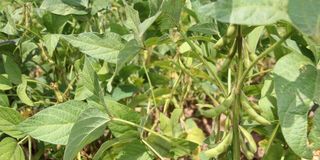Soya, the magic crop changing Vihiga women’s fortunes

Soya bean plants. The crop is changing the lives of women farmers in Vihiga County.
What you need to know:
- The farmers add value to their produce, processing some into powder used for making a beverage.
- According to the WHO, consuming soya protein as part of a diet low in cholesterol and saturated fat is one way of reducing the risk of heart disease.
Susan Kasei speaks of soya bean farming with such fulfilled excitement. From the first harvest of one 90kg bag from her half-acre land in Itambo village, Vihiga County, her life looked up.
“I’d harvest just 10kg of maize and I’d say I’m an excellent farmer not knowing that I was actually a poor farmer,” she says.
For every kilogramme of soya bean, she earned Sh200 compared to Sh160 for the 2kg tin of maize.
“The earnings are impressive. Now I know I’m a good farmer,” she says with a laugh.
Susan had zero information about either the profitability or nutritional value of soya until she met officers from the Ministry of Agriculture during farmers’ training in Vihiga.
“For years, we had been obsessed with maize; we didn’t know there was soya bean that would put money into our pockets, improve our farms’ soil fertility and boost our health,” she says.
Also read: Rural women, a nation’s powerful force
“I started harvesting a sack from the half acre after rotating the soya bean with maize. I was so excited.”
Scientists say soya beans have the ability to convert atmospheric nitrogen gas into ammonium, through their symbiotic association with bacteria called rhizobia, thus improving the health of crops, and ultimately increasing the yields.
Susan says a local nongovernmental organisation further trained her in adding value to the soya.
“I make soy drink powder and package it for the customers. If one wants 250g, for example, I sell it to her at Sh50.”
She says since her children started taking the soya bean butter she makes at home, their skins have turned “smooth and shining”.
Also read: Empower rural women to boost food security
“I’ll advise women to shift to soya bean farming. There is a market and they will fetch you good returns.”
Monica Kagonyi from Lugaga-Wamuluma ward in the same county is equally happy. She is a living witness of the soya bean magic.
“You know I used to harvest just five tins of maize from my acre farm,” she says.
“When you’re hungry, you can’t wait to harvest the dry maize. You keep eating the green maize from the farm and by the time you harvest it’s too little to sustain your family.”
That’s different from soya bean.
“You don’t have an option of eating green soya beans. You must wait until they mature and you dry them. Because of that, I harvested two sacks from the one acre and made really good money.”
She retailed a kilogramme of the dried soybean at Sh300 when 2kg of maize was selling at Sh130.
“You can mill soya beans and mix with wheat flour to make mandazi or cake. You can also make soya meatballs. They are nutritious,” she says.
According to the World Health Organisation, consuming soya protein as part of a diet low in cholesterol and saturated fat is one way of reducing the risk of heart disease.





